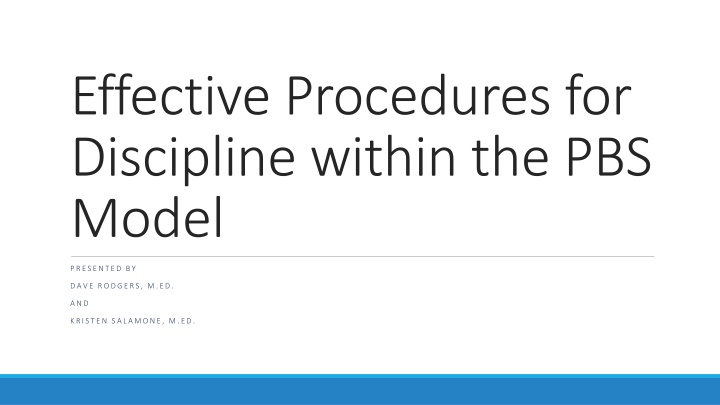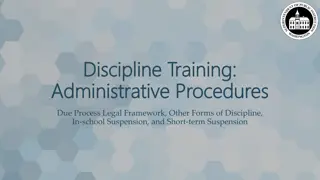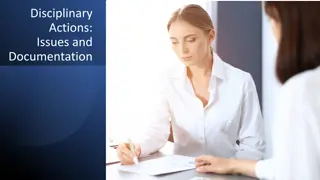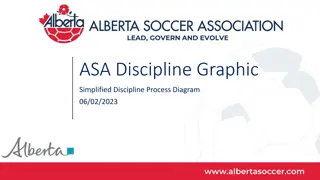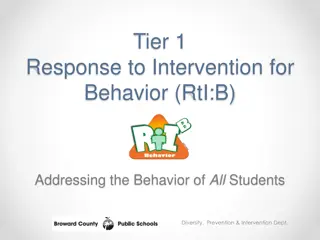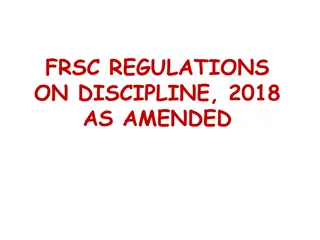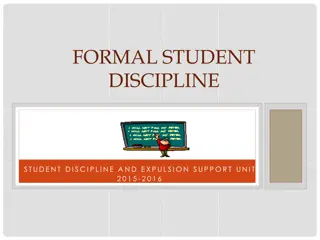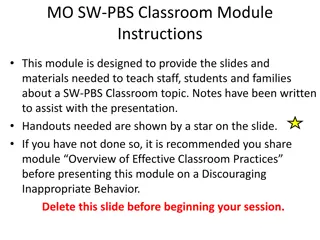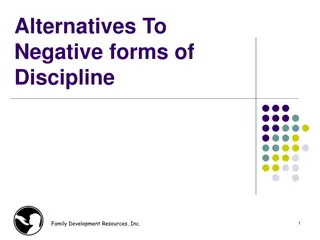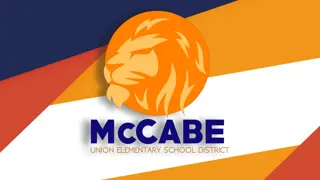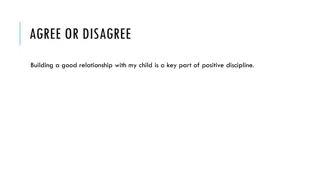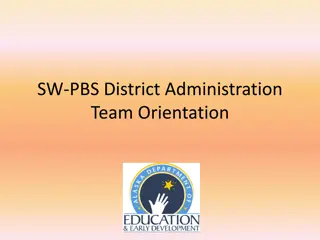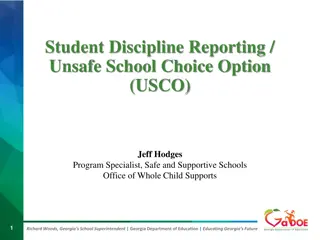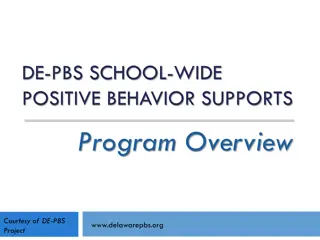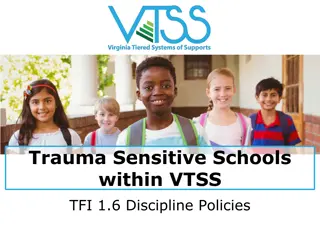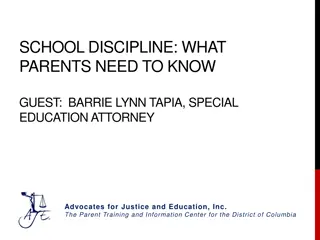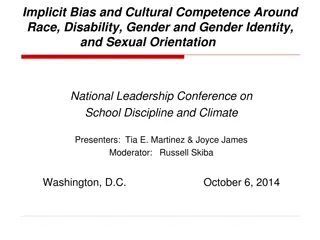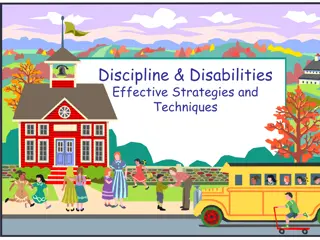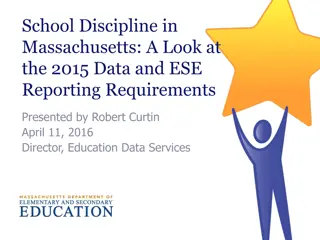Effective Procedures for Discipline within the PBS Model
Discipline within the PBS model focuses on promoting appropriate behavior, decreasing problem behaviors, and ensuring student success. It involves implementing steps, policies, and actions to support learning environments. Strategies include teaching social skills, addressing triggers of problem behavior, and modifying consequences. Inappropriate disciplinary procedures like office referrals and punishments may have negative consequences, emphasizing the need for a balanced approach that considers students' educational and mental well-being.
Download Presentation

Please find below an Image/Link to download the presentation.
The content on the website is provided AS IS for your information and personal use only. It may not be sold, licensed, or shared on other websites without obtaining consent from the author.If you encounter any issues during the download, it is possible that the publisher has removed the file from their server.
You are allowed to download the files provided on this website for personal or commercial use, subject to the condition that they are used lawfully. All files are the property of their respective owners.
The content on the website is provided AS IS for your information and personal use only. It may not be sold, licensed, or shared on other websites without obtaining consent from the author.
E N D
Presentation Transcript
Effective Procedures for Discipline within the PBS Model PRESENTED BY DAVE RODGERS, M.ED. AND KRISTEN SALAMONE, M.ED.
Learning Outcomes The learner will be able to: 1. Define discipline within the PBS model 2. Identify appropriate and inappropriate (illegal) disciplinary procedures 3. Identify the importance of pairing skills teaching with punitive consequences 4. Identify strategies for developing continuums of consequences
Discipline Discipline is the collection of implemented steps, policies, or actions developed to support teaching and learning environments so the likelihood of student academic and social success is promoted, in particular, 1. Increases in the likelihood of occurrences of socially appropriate behavior. 2. Decreases in the likelihood of occurrences of problem or rule violating behavior. 3. Decreases in the intensity, frequency, and duration of severe problem behavior. -Sugai (2009)
To achieve these outcomes, the emphases are on 1. Teaching and reinforcing context-appropriate social behaviors or skills. 2. Removing antecedent factors that trigger occurrences of problem behavior. 3. Adding antecedent factors that trigger occurrences of context appropriate social skills. 4. Removing consequence factors that maintain (function) occurrences of problem behaviors. 5. Adding consequence factors that maintain occurrences of context appropriate social behaviors. -Sugai (2009)
Appropriate and Inappropriate Disciplinary Procedures
Office referrals, suspensions and expulsion form school are typically used to punish students, alert parents, and protect others. It has unintentional side effects: 1. May exacerbate academic deterioration 2. With no educational alternative, alienation, delinquency, crime, and substance abuse may ensue. 3. Social, emotional, and mental health support can decrease the need for these measures. -Sprague (2014)
Punishment may worktemporarily 1. Removes the student from problem situation 2. Provides relief to school staff BUT The responsibility for behavioral change falls on the student and/or family.
Aversive Techniques defined by PA Chapter 14 (e) The following aversive techniques of handling behavior are considered inappropriate and may not be used by agencies in educational programs: (1) Corporal punishment. (2) Punishment for a manifestation of a student s disability. (3) Locked rooms, locked boxes or other structures or spaces from which the student cannot readily exit. (4) Noxious substances. (5) Deprivation of basic human rights, such as withholding meals, water or fresh air. (6) Suspensions constituting a pattern under 14.143(a) (relating to disciplinary placement). (7) Treatment of a demeaning nature. (8) Electric shock.
Restorative Discipline Restorative practices used in school: 1. Staff and students act in nonjudgmental ways toward one another 2. Adults and students work to understand the impact of their actions on others. 3. A fair process exists for learning from harm that has been done due to behaviors. 4. Responses to difficult behaviors have positive outcomes for everyone. -Sprague (2014)
Pairing Skills Teaching with Discipline Consider this Until we have defined, taught, modeled, practiced, reinforced and re-taught, it is unethical for adults to punish Rob Horner
If a child doesnt know how to read, we teach. If a child doesn t know how to swim, we teach. If a child doesn t know how to multiply, we teach. If a child doesn t know how to drive, we teach. If a child doesn t know how to behave, we ? Why can t we finish the last sentence as automatically as we do the others? (Horner, 1998)
Punishment assumes a motivation issue. It is not effective for skill deficit based behaviors.
Skill Deficits and Other Contributing Factors Executive Functioning Cognitive Processing Communication Biological (hungry, tired, thirsty) Culture Socioeconomics Stress
Skill deficits and/or significant antecedent factors must be dealt with before punitive measures by themselves can be effective.
Developing continuums of consequences
Considerations for Development 1. Behaviors do NOT occur in a vacuum; They have predictable antecedents and maintaining consequences. 2. Pain or humiliation strategies should never be utilized as punishment. 3. By definition, punishment is a contingent consequence that is associated with a decreased likelihood of the future occurrence of a behavior. 4. Punishment by itself is typically not sufficient. It works best when paired with a nurturing environment with high rates of positive adult attention, and academic and social success. 5. SWPBIS discipline systems should work for most students and be utilized to identify students who need individualized systems. -Sugai (2009)
Developing a Continuum 1. Displays of expected behavior 4. Minor, interfering problem behavior 7. Office managed major 5. Repeated minor problem behavior 2. Prompts for desired behaviors 3. Minor, not interfering problem behavior 6. Classroom managed major -Sugai (2009)
1. Displays of expected behavior 1. Look continuously for displays of expected behavior. 2. Label display of expected behavior (rule) 3. Provide context appropriate and relevant positive reinforcement.
2. Prompts for desired behavior 1. Provide effective signal, reminder, hint where and before problem behavior likely. (Pre- correction) 2. Label display of expected behavior (rule).
3. Minor, not interfering problem behavior 1. If possible, remove attention 2. Wait for display of expected behavior and provide positive reinforcement 3. When problem behavior ends, prompt expected behavior 4. Provide positive reinforcement for other-student displays of desired behavior 5. Provide minor aversive consequence immediately following the problem behavior
4. Minor, interfering problem behavior 1. Signal error or problem behavior observed 2. Remind/ask student for expected behavior 3. Ask student to display/practice expected behavior 4. Provide immediate and effective positive reinforcement after displays of desired of desired behavior. 5. 1. and 2.
5. Repeated minor problem behavior 1. Identify context/setting/condition when problem behavior most likely to occur. 2. Conduct functional assessment 3. Develop antecedent and consequence actions based on predictable factors that trigger (antecedent) and maintain (consequence) problem and expected behavior. 4. 1. and 2.
6. Classroom managed major 1. Develop pre-correction plan 2. Teach/practice desired behavior 3. Conduct FBA 4. 1. and 2.
7. Office managed major 1. Follow school and district disciplinary procedures 2. 1. and 2.
Sample Bridgehampton School District- Continuum of Consequences
S School chool- -wide Consequence Continuum wide Consequence Continuum Level 1 Disciplinary Options Classroom Level interventions/consequences Teachers use the following interventions to help the students change behavior in the classroom. If these interventions are successful, referral to the school administrator may not be necessary. Warning Letter of apology Loss of privileges Use of Student Problem-Solving worksheet Seat change Parent contact Teacher conference with student Confiscation of item Appropriate when Level 1 intervention/consequence has been ineffective. Teachers use the following interventions to help the students change behavior in the classroom. Referral to the school administrator may be necessary.(May use Level 1 interventions) Parent/guardian involvement Phone call/ letter to parent or guardian Referral to school counselor Referral to Behavior Intervention Specialist Confiscation of item Conference with parent or guardian Behavior agreement between teacher/student Teacher and/ or administrator conference with student and/or parent Loss of parking privilege Appropriate when Level 2 intervention/ consequence has been ineffective. Office referral required Parent/ guardian notification required Referral to school social worker Detention Restitution In-school suspension Restricted activity Appropriate when Level 3 intervention/ consequence has been ineffective. Office referral required Parent/ guardian notification required Modified school day Appropriate when Level 4 intervention/ consequence has been ineffective Office referral required Parent/ guardian notification required Criminal charges possible Appropriate when Level 5 intervention/ consequence has been ineffective Office referral required Parent/ guardian notification required Long term suspension as levied by the Superintendent or designee In-class time out Reinforcement of appropriate behaviors Written reflection about incident Before or after school detention Behavior contract Mentoring Other conference between any involved parties 2 Parent contract Parent or guardian accompany student to school or classes Conflict resolution Peer mediation Class or schedule change Restricted activity In-school intervention (ex: work assignment, behavior essays, transportation restriction Lunch Detention 3 Alternative Programs (SOAR, Tobacco Awareness, Behavior Intervention Services, After School, FLIGHT) Search of individual, possessions, lockers, desk or vehicle Metal detector scan or canine search Suspension (1-5 days) May use Level 2 interventi ons 4 5 6 Alternative Programs Referral to the Alternative school-based program Suspension (6-10 days) May use Level 3 interventi ons Extended Suspension (10 days) Referral to the Alternative school-based program Referral to Alternative school-based program These levels of consequence are levied only by the Superintendent/ Designee. www.ncpublicschools.org/positivebehavior/
Group Activity In groups of 5, discuss disciplinary procedures utilized in your building/program. Do they address skill deficits? How is data collected on problem behaviors? What is your schools policies on suspension/expulsion? Based on the information reviewed today, what does your school do well with regarding discipline and/or what could they improve on? We will have a discussion after groups have time to discuss.
References NC PBIS Resource 1 (2011). www.ncpublicschools.org/positivebehavior/ Sprague, J. (2014). SWPBIS and restorative discipline in schools: Challenges and opportunities, University of Oregon Sugai, G. (2009). Responding to non-responsive behavior: Basic practices and systems, Center on Positive Behavioral Interventions and Supports. www.pbis.org.
Contact Information Dave Rodgers TaC Consultant BVIU 724-774-7800 ext. 3026 drodgers@bviu.org Kristen Salamone TaC Consultant BVIU 724-774-7800 ksalamone@bviu.org To obtain a copy of today s materials, please visit: http://tinyurl.com/CoachesDay
